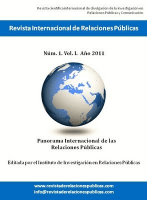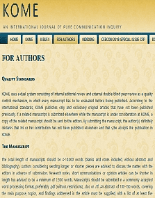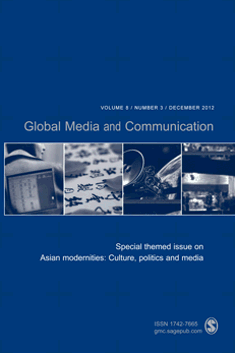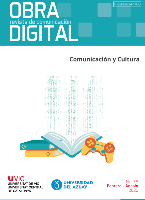
Communitas
Scope & Guideline
Unlocking New Insights in Socio-Linguistic Research
Introduction
Aims and Scopes
- Exploration of Communication Strategies:
The journal emphasizes the study of communication strategies across different sectors, including government, non-profit organizations, and media. It investigates how these strategies influence public perception and community engagement. - Analysis of Media Representation:
A key focus is on media representation and bias, particularly in relation to significant societal issues such as COVID-19, social justice, and cultural identity. This includes critical examinations of how media shapes narratives and public discourse. - Integration of Digital Communication:
The journal addresses the impact of digital platforms on communication practices, covering topics like social media's role in shaping cultural identities and brand communication. - Sustainability and Social Responsibility:
There is a consistent focus on sustainable practices within communication frameworks, particularly in relation to corporate social responsibility and community engagement initiatives. - Cultural and Contextual Studies:
The journal explores the dynamics of cultural diversity and marginalization in communication, promoting studies that highlight underrepresented voices and perspectives.
Trending and Emerging
- Impact of COVID-19 on Communication:
There is a notable trend in exploring the implications of the COVID-19 pandemic on communication practices, particularly in governmental health communication and public response. This theme addresses how crises shape communication strategies and public engagement. - Digital and Social Media Influence:
The influence of social media on communication dynamics is gaining traction, with studies focusing on metrics, branding, and cultural impact among users, particularly youth. This reflects a growing recognition of digital spaces as crucial for contemporary communication. - Strategic Partnerships and Sustainability:
Emerging research emphasizes the role of strategic partnerships in addressing sustainability challenges, particularly in sectors like food security and corporate social responsibility. This trend highlights collaboration as a key component in achieving social goals. - Cultural Identity and Marginality:
There is an increasing focus on cultural identity, representation, and marginalization within communication studies, particularly in the South African context. This theme underscores the importance of inclusivity and diverse perspectives in communication research. - Innovative Learning Approaches in Communication Education:
The exploration of new educational methodologies, such as experiential learning and blended learning in communication programs, is trending. This reflects a shift towards preparing students for the complexities of modern communication landscapes.
Declining or Waning
- Traditional Media Studies:
There appears to be a waning interest in traditional media studies, particularly in examining conventional broadcast practices. The recent titles suggest a shift towards digital and social media platforms, leaving less room for discussions centered solely on traditional media. - Static Communication Models:
Research focusing on static models of communication, such as one-way communication frameworks, has decreased. The current trend leans towards dynamic and interactive communication methods that reflect contemporary social engagement. - Crisis Communication:
Although crisis communication was once a focal point, particularly during the pandemic, the frequency of studies on this theme has diminished as the focus shifts to broader communication strategies and long-term sustainability. - Local Historical Contexts:
While historical perspectives remain important, there seems to be less emphasis on localized historical analyses in communication, with more recent works focusing on contemporary issues and future-oriented studies.
Similar Journals

Revista de Comunicacion-Peru
Advancing Knowledge in Communication and Media Analysis.Revista de Comunicación-Perú is a distinguished open-access journal published by Universidad de Piura, with a dedicated focus on communication studies. Since its inception in 2002, the journal has provided a vital platform for researchers, professionals, and students to disseminate knowledge and foster discourse in the field of communication. As of 2023, it proudly holds a Q1 classification in the Communication category and ranks impressively in Scopus, placing at #117 out of 1304 in Cultural Studies and #160 out of 511 in Communication, demonstrating its significant impact within the academic community. The journal’s scope encompasses diverse topics related to communication, cultural discourse, and media analysis, making it an essential resource for those seeking to explore contemporary issues in these areas. With a commitment to promoting scholarly exchange, Revista de Comunicación-Perú continues to play a pivotal role in shaping the communication landscape in Peru and beyond.

Revista Internacional de Relaciones Publicas
Elevating standards in public relations scholarship.Revista Internacional de Relaciones Publicas is a prominent open-access journal dedicated to advancing the field of public relations and communication research. Published by UNIV MALAGA, INST INVESTIGACION RELACIONES PUBLICAS, this journal has been pivotal since its establishment in 2011 in disseminating innovative research and insights related to public relations practices, theories, and trends globally. With the ISSN 2174-3681, the journal reaches a diverse audience, including researchers, professionals, and students, fostering a collaborative environment for knowledge exchange. Despite the absence of an HIndex or categorized quartiles, its commitment to high academic standards ensures the relevance and quality of published work. Situated in the vibrant city of Malaga, Spain, the journal encourages contributions that explore the evolving dynamics of public relations in contemporary society, making it an essential resource for anyone interested in the nuances of communication strategies and their impacts.

Popular Communication
Transforming Insights into Impactful DialoguePopular Communication, published by Routledge Journals, Taylor & Francis Ltd, is a leading academic journal in the field of Communication, recognized for its Q1 ranking in the 2023 Scopus category. With an ISSN of 1540-5702 and an E-ISSN of 1540-5710, this journal has been converging significant research from 2010 to 2024, highlighting contemporary trends and evolving dynamics in popular communication practices. The journal is based in the United Kingdom and focuses on the intersection of media, culture, and communication, making it a vital resource for researchers, professionals, and students interested in understanding the impact of communication in society today. Although it does not offer Open Access options, it remains a cornerstone for scholarly discourse, with an impressive rank of #96 out of 511 in Social Sciences Communication, placing it in the 81st percentile. Contributions to this journal play a critical role in advancing knowledge and encouraging further scholarship in the diverse realm of popular communication.

KOME-An International Journal of Pure Communication Inquiry
Fostering Global Dialogue in Communication and LinguisticsKOME-An International Journal of Pure Communication Inquiry is a scholarly journal published by Ludovika University Press in Hungary, dedicated to advancing the study and understanding of communication across various contexts. Since its inception in 2012 as an open-access journal, KOME aims to foster a vibrant dialogue among researchers, professionals, and students by providing a platform for innovative research in the fields of Communication and Linguistics. With its recent classification as a Q3 journal in Communication and Q2 in Linguistics and Language, KOME stands out as a valuable resource, ranking in the 70th percentile for Linguistics and Language and 47th percentile for Communication in Scopus. Researchers are encouraged to submit original articles, reviews, and case studies that contribute to the evolving discourse on pure communication inquiries. Located at Ludovika ter 2, Budapest, this journal not only promotes academic excellence but also ensures that scholarly works are accessible to a global audience, reinforcing the importance of communication studies in our interconnected world.

CIC-Cuadernos de Informacion y Comunicacion
Illuminating Contemporary Challenges in Information and CommunicationCIC-Cuadernos de Informacion y Comunicacion is a leading academic journal published by the Universidad Complutense de Madrid, serving as a vital resource for scholars and practitioners in the fields of information and communication studies. Launched in 1995 as an Open Access journal, it provides an invaluable platform for disseminating innovative research and critical analysis related to communication theory, media studies, and information technology. With its focus on fostering interdisciplinary dialogue, CIC encourages submissions that explore contemporary challenges and advancements in the information landscape. Although the H-index and Scopus rankings are currently not specified, the journal’s commitment to excellence and accessibility positions it as an important contributor to academic discourse. The journal is based in Madrid, Spain, and aims to reach a global audience of researchers, professionals, and students dedicated to furthering knowledge in the rapidly evolving domains of communication and information sciences.

Revista Internacional de Comunicacion y Desarrollo
Transforming Ideas into Impactful CommunicationRevista Internacional de Comunicación y Desarrollo is a pioneering journal in the field of communication studies, dedicated to fostering dialogue and disseminating research on the interplay between communication and societal development. Published by UNIV SANTIAGO COMPOSTELA, this journal provides a vital platform for scholars, researchers, and practitioners to explore contemporary issues within the realm of communication, media, and their impact on social progress. With an ISSN of 2386-3730, the journal focuses on innovative research that bridges theory and practice, making it an essential resource for those engaged in transformative communication practices. Although currently not listed as an open-access journal, it remains accessible to a broad audience, promoting inclusivity in academic discourse. As communication continues to evolve in response to global challenges, the Revista Internacional de Comunicación y Desarrollo stands out as an influential voice, aiming to shape the future of communication disciplines through rigorous scholarship and critical exploration of its role in development.

Turkiye Iletisim Arastirmalari Dergisi-Turkish Review of Communication Studies
Fostering Innovative Research in Communication Dynamics.Turkiye Iletisim Arastirmalari Dergisi, also known as the Turkish Review of Communication Studies, is an esteemed academic journal published by Marmara University, Faculty of Communication. Since its establishment as an Open Access journal in 2000, it has been committed to advancing the field of communication studies, offering a platform for innovative research and discourse in this dynamic discipline. With an ISSN of 2630-6220, the journal seeks to bridge the gap between theory and practice, addressing various sub-disciplines such as media studies, interpersonal communication, and public relations. Situated in the vibrant academic landscape of Istanbul, Turkiye, the journal aims to foster scholarly dialogue among researchers, professionals, and students, contributing significantly to the global communication research community. As it continues to grow in relevance and impact, Turkiye Iletisim Arastirmalari Dergisi plays a vital role in promoting diverse perspectives and enhancing the understanding of communication processes in contemporary society.

Communiquer
Empowering Voices, Enriching Perspectives.Communiquer is a distinguished open-access journal published by UNIVERSITÉ DU QUÉBEC À MONTRÉAL (UQAM), focusing on the vibrant fields of Communication and Linguistics. Since its inception in 2009, it has gained recognition for fostering scholarly dialogue and disseminating groundbreaking research. Hailing from Canada, the journal aims to provide a platform for researchers, practitioners, and students to explore the dynamic interplay between language and communication. With a current impact factor that places it in the Q4 category for Communication and Q3 for Linguistics and Language in 2023, Communiquer promotes innovative investigations and diverse perspectives, encouraging interdisciplinary collaboration. Despite its relatively emerging status—ringing in at percentile rankings of 28th and 11th in its respective fields—it continues to contribute significantly to the academic landscape. Scholars looking to publish and access pertinent research will find Communiquer an essential resource that supports the advancement of knowledge in these crucial disciplines.

Global Media and Communication
Transforming Perspectives on Communication in a Digital AgeGlobal Media and Communication is a premier journal dedicated to advancing the fields of media and communication studies, published by SAGE Publications Ltd. With an ISSN of 1742-7665 and an E-ISSN of 1742-7673, this journal offers a platform for scholarly discourse and innovative research that explores the intricate relationships between global media practices and communication strategies. Recognized as a Q1 journal in both the Arts and Humanities (Miscellaneous) and Communication categories for 2023, it stands out in its commitment to delivering high-quality, peer-reviewed articles that contribute to the understanding of contemporary media landscapes. Located in London, United Kingdom, the journal benefits from being at the heart of cultural and digital innovation. Researchers, professionals, and students can look forward to insightful articles that not only critique existing frameworks but also propose new methodologies, ensuring that Global Media and Communication remains a vital resource for anyone interested in navigating the evolving dynamics of media and communication on a global scale.

Obra Digital-Revista de Comunicacion
Navigating the evolving landscape of digital media and culture.Obra Digital-Revista de Comunicacion is a leading academic journal in the field of communication studies, published by UNIV VIC in Spain. Since its establishment in 2011, it has embraced an Open Access model, ensuring that research outputs are freely available to a global audience, thus fostering greater accessibility and collaboration among scholars. With an ISSN of 2014-5039, the journal aims to provide a pivotal platform for the dissemination of innovative research that addresses contemporary issues in communication theory and practice. The journal’s scope encompasses a wide range of topics, including digital media, interpersonal communication, and cultural studies, making it an essential resource for researchers, professionals, and students alike. Despite the absence of an HIndex and specific ranking metrics, Obra Digital stands out as a valuable forum for critical dialogue and scholarly exploration in the evolving landscape of communication. As the field continues to grow, this journal remains committed to advancing knowledge and fostering academic discourse.